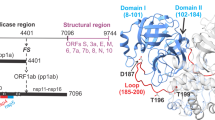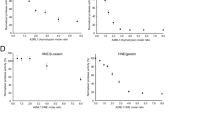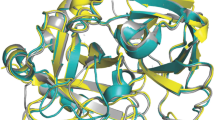Abstract
Chemical synthesis was used to prepare the HIV-1 protease specifically 13C-labelled in the catalytically essential Asp 25 in each monomer. The NMR chemical shift of the 13C-enriched homodimeric enzyme was measured in the presence of the inhibitor pepstatin, a mimic of the tetrahedral intermediate formed in enzyme catalysis. In this complex, the catalytic carboxyls do not titrate in the pH range where the enzyme is active; throughout the range pH 2.5–6.5, one Asp 25 side chain is protonated and the other deprotonated. By contrast, in the absence of inhibitor the two Asp side chains are chemically equivalent and both deprotonated at pH 6, the optimum for enzymatic activity. These direct observations of the chemical properties of the catalytic apparatus of the enzyme provide concrete information on which to base the design of improved HIV-1 protease inhibitors.
This is a preview of subscription content, access via your institution
Access options
Subscribe to this journal
Receive 12 print issues and online access
$189.00 per year
only $15.75 per issue
Buy this article
- Purchase on Springer Link
- Instant access to full article PDF
Prices may be subject to local taxes which are calculated during checkout
Similar content being viewed by others
References
Ratner, L. et al. Complete nucleotide sequence of the AIDS virus, HTLV-III. Nature 313, 277–284 (1985).
Oroszlan, S. in Viral Proteinases as Targets For Chemotherapy (Eds H. Kräusslich, S. Oroszlan, E. Wimmer) 87–100 (Cold Spring Harbor Laboratory Press, Cold Spring Harbor, 1989).
McQuade, T.J. et al. A synthetic HIV-1 protease inhibitor with antiviral activity arrests HIV-like particle maturation. Science 247, 454–456 (1990).
Huff, J.R. HIV protease: a novel chemotherapeutic target for AIDS. J. Med. Chem. 34, 2305–2314 (1991).
Cohen, J. Results on new AIDS drugs bring cautious optimism. Science. 271, 755–756 (1996).
FDA Press Release (♯95–10), 7 December (1995); and, (♯96–4), 1 March (1996).
Rose, R.E. et al. Human immunodeficiency virus type 1 viral background plays a major role in development of resistance to proteinase inhibitors. Proc. Natl. Acad. Sci. USA 93, 1648–1653 (1996).
Condra, J.H. et al. In vivo emergence of HIV-1 variants resistant to multiple protease inhibitors. Nature 374, 569–571 (1995).
Hartsuck, J.A. & Tang, J. The carboxylate ion in the active center of pepsin. J. Biol. Chem. 247, 2575–2580 (1972).
Pearl, L.H. & Taylor, W.R. A structural model for the retroviral proteases. Nature 329, 351–354 (1987).
Pretsch, E., Clerc, T., Seibl, J. & Simon, W. Spectral Data for Structure Determination of Organic Compounds (Springer-Verlag, Berlin, 1989).
Holladay, M.W., Salituro, F.G. & Rich, D.H. Synthetic and enzyme inhibition studies of pepstatin analogues containing hydroxyethylene and ketomethylene dipeptide isosteres. J. Med. Chem. 30, 374–383 (1987).
Toth, M.V. & Marshall, G.R. A simple, continuous fluorometric assay for HIV protease. Int. J. Pept. Protein. Res. 36, 544–550 (1990).
Hyland, L.J., Tomaszek, T.A. & Meek, T.D. Human immunodeficiency virus-1 protease. 2. Use of pH rate studies and solvent kinetic isotope effects to elucidate details of chemical mechanism. Biochemistry 30, 8454–8463 (1991).
Furfine, E.S. et al. Two-step binding mechanism for HIV protease inhibitors. Biochemistry 31, 7886–7891 (1992).
Yamazaki, T. et al. NMR and X-ray evidence that the HIV protease catalytic aspartyl groups are protonated in the complex formed by the protease and a non-peptide cyclic urea-based inhibitor. J. Amer. Chem. Soc. 116, 10791–10792 (1994).
Fitzgerald, P.M.D. et al. Crystallographic analysis of a complex between human immunodeficiency virus type 1 protease and acetyl-pepstatin at 2.0-Å resolution. J. Biol. Chem. 265, 14209–14219 (1990).
McDaniel, D.H. & Brown, H.C. Hydrogen bonding as a factor in the ionization of dicarboxylic acids. Science 118, 370–374 (1953).
Frey, P.A., Whitt, S.A. & Tobin, J.B. A low-barrier hydrogen bond in the catalytic triad of serine proteinases. Science 264, 1927–1930 (1994).
Marciniszyn, J.A., Hartsuck, J.A. & Tang, J.J. Mode of inhibition of acid proteases by pepstatin. J. Biol. Chem. 251, 7088–7094 (1976).
Marshall, G.R. Structure-activity relations of antagonists of the reninangiotensin system. Fed. Proc. 35, 2494–2501 (1976).
Suguna, K., Padlan, E.A., Smith, C.W., Carlson, W.D. & Davies, D.R. Binding of a reduced bond peptide inhibitor to the aspartic proteinase from rhizopus chinesis: implications for a mechanism of action. Proc. Natl. Acad. Sci. USA 84, 7009–7013 (1987).
Schnölzer, M. & Kent, S.B.H. Constructing proteins by dovetailing unprotected synthetic peptides: backbone-engineered HIV protease. Science 256, 221–225 (1992).
Tóth, G. & Penke, B. An improved method for the preparation of omega-cyclohexyl esters of aspartic and glutamic acid. Synthesis 361–362 (1992).
Schnölzer, M., Alewood, P., Jones, A., Alewood, D. & Kent, S.B.H. In situ neutralization in Boc-chemistry sol id phase peptide synthesis: rapid, high yield assembly of difficult sequences. Int. J. Pept. Protein Res. 40, 180–193 (1992).
Grant, S.K. et al. Use of protein folding studies to determine the conformational and dimer stabilities of HIV-1 and SIV proteases. Biochemistry 31, 9491–9501 (1992).
Wlodawer, A. et al. Conserved folding in retroviral proteases: crystal structure of a synthetic HIV-1 protease. Science 245, 616–621 (1989).
Mildner, A.M. et al. The HIV-1 protease as enzyme and substrate: mutagenesis of autolysis sites and generation of a stable mutant with retained kinetic properties. Biochemistry 33, 9405–9413 (1994).
Bergman, D.A. et al. Kinetic properties of HIV-1 protease produced by total chemical synthesis with cysteine residues replaced by isosteric L-α-n-butyric acid. Lett. Pept. Sci. 2, 99–107 (1995).
Author information
Authors and Affiliations
Rights and permissions
About this article
Cite this article
Smith, R., Brereton, I., Chai, R. et al. Ionization states of the catalytic residues in HIV-1 protease. Nat Struct Mol Biol 3, 946–950 (1996). https://doi.org/10.1038/nsb1196-946
Received:
Accepted:
Issue Date:
DOI: https://doi.org/10.1038/nsb1196-946
This article is cited by
-
Inhibition of the activity of HIV-1 protease through antibody binding and mutations probed by molecular dynamics simulations
Scientific Reports (2020)
-
An insight to the molecular interactions of the FDA approved HIV PR drugs against L38L↑N↑L PR mutant
Journal of Computer-Aided Molecular Design (2018)
-
Pentacycloundecane lactam vs lactone norstatine type protease HIV inhibitors: binding energy calculations and DFT study
Journal of Biomedical Science (2015)
-
Non-infectious in-cell HIV-1 protease assay utilizing translocalization of a fluorescent reporter protein and apoptosis induction
Archives of Pharmacal Research (2015)
-
Energetic basis for drug resistance of HIV-1 protease mutants against amprenavir
Journal of Computer-Aided Molecular Design (2012)



